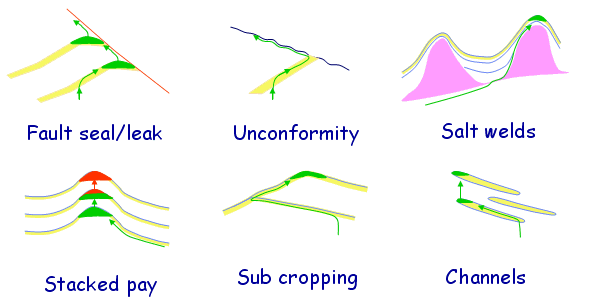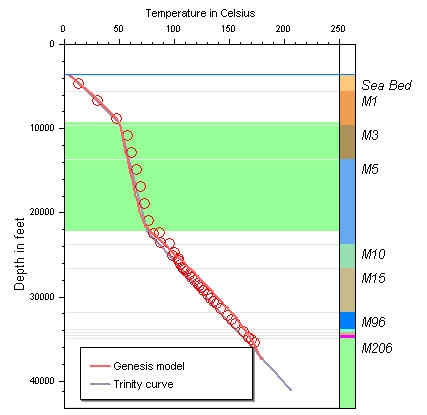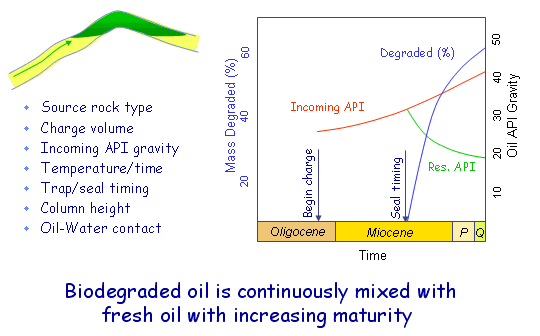| Introduction to Trinity T3 |
| | Home... | Gallery... | Brochure ... | Products ... | |
T3 has many additional features on top of the standard Trinity version. The largest leap in T3 is to allow tracking of hydrocarbon fluid volumes and properties while they migration in 3D space. Interactive 3D migration allows petroleum system analysist to de-risk migration scenarios for proepects.The following figure shows the ability of T3 to model various geological scenarios where migration occurs vertically.

Temperature And Allocthonous Salt
Another important feature of T3 is its ability to correct for the conductivity effects of allocthonous salt. This feature improves the ability to model sub salt source rock thermal history and maturation. The figure below shows a temperature profile at a well location in T3, where the Trinity temperature (blue line) agrees with temperature data and Temis3D model results.

Interactive Biodegradation Tool
T3 includes an interactive fluid property/ biodegradation risking tool. The instantaneous fluid properties are calculated as a function of source facies and maturity in the fetch area. The fluids are mixed in the reservoir with existing fluids from earlier charge that may be biodegraded. The biodegradation model, considers trap OWC area, column height, nutrient supply, temperature and residence time. User can interactively investigate the possibility of biodegradation and provide best estimate of API gravity for a prospect. Migration losses and migration delay time also will affect the property of the charging oil.

In the figure above, the arrows indicate the time when oil charge begins and time when a competent seal is formed. The arriving oil at present day is 40 API but as 60 percent of the cumulative oil has been biodegraded, the oil in the reservoir now stands at 20 API.
If the reservoir temperatuers are high and biodegradation is not a risk. This tool can be used to look at instantaneous and cumulative fluid API of the oil charge and trap timing effects on oil API.
- Cross strata 3D migration. User can interactively inject volumes to investigate 3D migration plumbing system or run 3D spider maps to scenario test migration models to compare with known accumulations and dry holes. It does this with PVT and completely interactivity (it takes only few seconds!);
- The ability to use a laterally variable top seal map at each carrier level to allow salt welds, faults, as well as effective stress week points to be used for vertical migration;
- Sub cropping, unconformity truncation can be used to automatically allow vertical leakage. 3D fault planes/surfaces to be used in diverting migration between structure surfaces;
- Allows facies maps to be associated with each carrier to look at migrating and charge via stacked channels, pinch outs, etc. Predicting pay /non-pay at different levels.
- Allows potentiometric surfaces to be defined at each horizon so hydrodynamic or over pressure effects can be modeled independently for each formation.
- Remigration: allows migration modeling through time by re-migrating existing accumulations and adding newly expelled volumes
- 3D structure movie with maturity maps draped paleo-structure map, evolving through time in 3D viewer.
- Automatically deflect temperature profile through salt to correct salt thickness effect based on an empirical model. Workflow to handle 3D salt effects.
- Multiple/unlimited thickness change models. This is used to model multiple phase salt thickness change though time or simulating effects of thrust duplication. Multiple thickness change maps can be associated with one interval to vary thickness in multiple episodes, and multiple layers can be associated with thickness change through time. Regular Trinity is limited to one layer and one event.
- Migration movie - continuous migration on a structure surface through time. This is a planned feature not available yet – technically not hard to do as we can already do it manually stepwise.
Copyright ©2001-2004, ZetaWare, Inc. All rights reserved